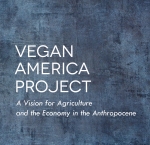 Martin Rowe
Martin Rowe
Two weekends ago, I had the good fortune to attend the Rethinking Animals Summit in New York City. As is the way with events such as this, panelists were alotted a brief amount of time for their presentation, during which most of them pitched their organization’s work (in one way or another), and then responded to questions and answers. In spite of the limitations of the format in engaging discussion and going more deeply into issues, however, two main themes stuck out for me.
The first is that conservationists—individuals who are primarily concerned with ecosystems, species survival, the wild, and “Nature” writ large—are finally recognizing the significance that the consumption of animals has for all of their concerns. From the outset, animal advocates (who’ve over the decades tended to focus on the welfare of individual animals within the human environment, and whose movement has defined itself through moral and social reform rather than environmentalism’s scientific analysis or transcendentalist aesthetic of the sublime) have found themselves at odds with those who’ve considered animals raised for food either as “unnatural,” or an invasive species, or a subject best not talked about for fear of appearing sentimental, unscientific, ideological, or insensitive to the realities that face subsistence farmers and the malnourished around the world.
The impact of globalized factory farming and monocultures of feed crops on fragile, vital ecosystems (either directly in terms of deforestation, resource use, pollution, and biodiversity loss or indirectly through adding to GHG emissions) is making it impossible to claim that our food preferences are merely personal choices with no policy or economic ramifications. This is a welcome realignment, offering the genuine possibility that we’ll finally see large environmental and social justice organizations start to work with animal protection organizations to offer a new vision of protecting the planet.
The second theme of the conference was the vital importance of the oceans. Anna Cummins of 5Gyres.org talked about the five major sites of plastic debris in the oceans; Carter and Olivia Ries, the dynamic 16- and 14-year-olds who run One More Generation, described their One Less Straw campaign, in which they are trying to make a dent in the percentage of the 500 million straws used each day in the U.S. alone that end up in the ocean and animals in that ocean. Others talked about the loss of tropical reefs and trophic cascade collapse.
Until recently, it has been hard for animal advocates to talk about fish: unlike land and air animals raised for food, fish caught and eaten are measured by the ton and not individually. Fish don’t look like us, they don’t rear their young like us, and their medium is alien to us. Furthermore, their emotional and social lives were unfamiliar, until scholars like Jonathan Balcombe gathered the research. Even so, advocates have tended to talk about high mercury and other toxic elements in fish and overfishing rather than no longer eating fish, whether wild caught or raised in tanks, because of the pain they feel or the societies we disrupt.
After this conference, it’s my judgment that animal advocates and environmentalists need to be much more forthright in how we approach the subject of eating fish. Even if it might not be possible to extend cetacean rights to fish, it seems self-evident now that those of us who can afford not to eat marine protein should stop doing so—to protect ecosystems and to allow those communities in the developing world who depend on them for their major source of protein to do so. We should argue that we need to do all we can to allow the fish populations to rebound—not just for us, but for all the other species that depend on them for survival.